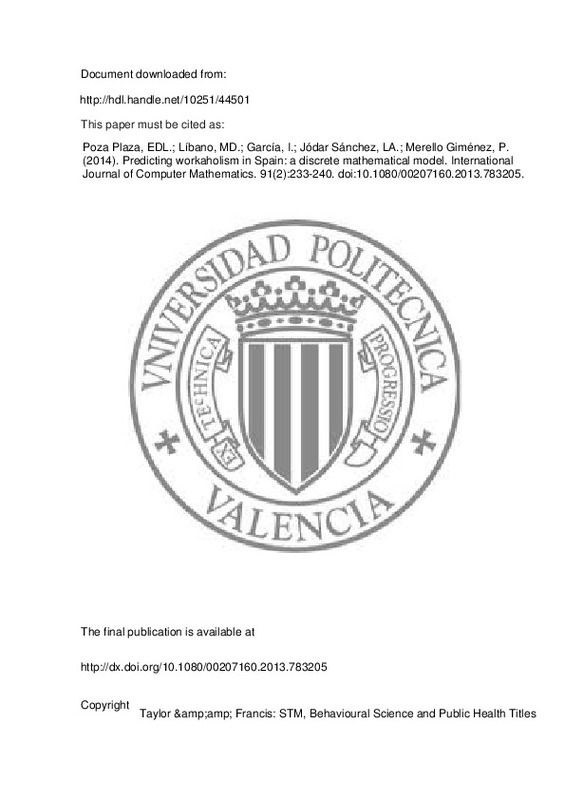Schou Andreassen, C., Ursin, H., & Eriksen, H. R. (2007). The relationship between strong motivation to work, «workaholism», and health. Psychology & Health, 22(5), 615-629. doi:10.1080/14768320600941814
Bowling, N. A., Beehr, T. A., & Swader, W. M. (2005). Giving and receiving social support at work: The roles of personality and reciprocity. Journal of Vocational Behavior, 67(3), 476-489. doi:10.1016/j.jvb.2004.08.004
Burke, R. J., & Koksal, H. (2002). Workaholism among a Sample of Turkish Managers and Professionals: An Exploratory Study. Psychological Reports, 91(1), 60-68. doi:10.2466/pr0.2002.91.1.60
[+]
Schou Andreassen, C., Ursin, H., & Eriksen, H. R. (2007). The relationship between strong motivation to work, «workaholism», and health. Psychology & Health, 22(5), 615-629. doi:10.1080/14768320600941814
Bowling, N. A., Beehr, T. A., & Swader, W. M. (2005). Giving and receiving social support at work: The roles of personality and reciprocity. Journal of Vocational Behavior, 67(3), 476-489. doi:10.1016/j.jvb.2004.08.004
Burke, R. J., & Koksal, H. (2002). Workaholism among a Sample of Turkish Managers and Professionals: An Exploratory Study. Psychological Reports, 91(1), 60-68. doi:10.2466/pr0.2002.91.1.60
Burke, R. J., Oberklaid, F., & Burgess, Z. (2004). Workaholism among Australian women psychologists: antecedents and consequences. Women in Management Review, 19(5), 252-259. doi:10.1108/09649420410545971
De la Poza, E., Guadalajara, N., Jódar, L., & Merello, P. (2013). Modeling Spanish anxiolytic consumption: Economic, demographic and behavioral influences. Mathematical and Computer Modelling, 57(7-8), 1619-1624. doi:10.1016/j.mcm.2011.10.020
Duato, R., & Jódar, L. (2013). Mathematical modeling of the spread of divorce in Spain. Mathematical and Computer Modelling, 57(7-8), 1732-1737. doi:10.1016/j.mcm.2011.11.020
Fry, L. W., & Cohen, M. P. (2008). Spiritual Leadership as a Paradigm for Organizational Transformation and Recovery from Extended Work Hours Cultures. Journal of Business Ethics, 84(S2), 265-278. doi:10.1007/s10551-008-9695-2
García, I., Jódar, L., Merello, P., & Santonja, F.-J. (2011). A discrete mathematical model for addictive buying: Predicting the affected population evolution. Mathematical and Computer Modelling, 54(7-8), 1634-1637. doi:10.1016/j.mcm.2010.12.012
Gustafsson, P. E., Janlert, U., Virtanen, P., & Hammarström, A. (2012). The association between long-term accumulation of temporary employment, the cortisol awakening response and circadian cortisol levels. Psychoneuroendocrinology, 37(6), 789-800. doi:10.1016/j.psyneuen.2011.09.011
Hochschild, A. (1997). The Time Bind. WorkingUSA, 1(2), 21-29. doi:10.1111/j.1743-4580.1997.tb00019.x
Nelder, J. A., & Mead, R. (1965). A Simplex Method for Function Minimization. The Computer Journal, 7(4), 308-313. doi:10.1093/comjnl/7.4.308
Ng, T. W. H., Sorensen, K. L., & Feldman, D. C. (2006). Dimensions, antecedents, and consequences of workaholism: a conceptual integration and extension. Journal of Organizational Behavior, 28(1), 111-136. doi:10.1002/job.424
W.E. Oates,Confessions of a Workaholic: The Facts about Work Addiction, World Publishing Company, New York, 1971.
Raafat, R. M., Chater, N., & Frith, C. (2009). Herding in humans. Trends in Cognitive Sciences, 13(10), 420-428. doi:10.1016/j.tics.2009.08.002
Robinson, B. E., & Post, P. (1997). Risk of Addiction to Work and Family Functioning. Psychological Reports, 81(1), 91-95. doi:10.2466/pr0.1997.81.1.91
Schaufeli, W. B., & Bakker, A. B. (2004). Job demands, job resources, and their relationship with burnout and engagement: a multi-sample study. Journal of Organizational Behavior, 25(3), 293-315. doi:10.1002/job.248
Schaufeli, W. B., Bakker, A. B., & Salanova, M. (2006). The Measurement of Work Engagement With a Short Questionnaire. Educational and Psychological Measurement, 66(4), 701-716. doi:10.1177/0013164405282471
Schaufeli, W. B., Taris, T. W., & van Rhenen, W. (2008). Workaholism, Burnout, and Work Engagement: Three of a Kind or Three Different Kinds of Employee Well-being? Applied Psychology, 57(2), 173-203. doi:10.1111/j.1464-0597.2007.00285.x
Schaufeli, W. B., Bakker, A. B., van der Heijden, F. M. M. A., & Prins, J. T. (2009). Workaholism, burnout and well-being among junior doctors: The mediating role of role conflict. Work & Stress, 23(2), 155-172. doi:10.1080/02678370902834021
Shimazu, A., Schaufeli, W. B., & Taris, T. W. (2010). How Does Workaholism Affect Worker Health and Performance? The Mediating Role of Coping. International Journal of Behavioral Medicine, 17(2), 154-160. doi:10.1007/s12529-010-9077-x
Sonnentag, S. (2003). Recovery, work engagement, and proactive behavior: A new look at the interface between nonwork and work. Journal of Applied Psychology, 88(3), 518-528. doi:10.1037/0021-9010.88.3.518
Yaniv, G. (2011). Workaholism and marital estrangement: A rational-choice perspective. Mathematical Social Sciences, 61(2), 104-108. doi:10.1016/j.mathsocsci.2010.11.006
[-]







![[Cerrado]](/themes/UPV/images/candado.png)


